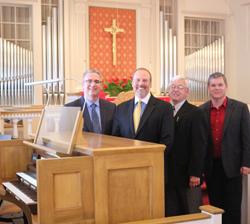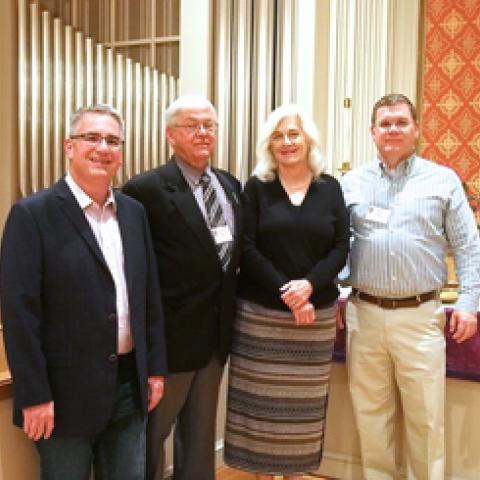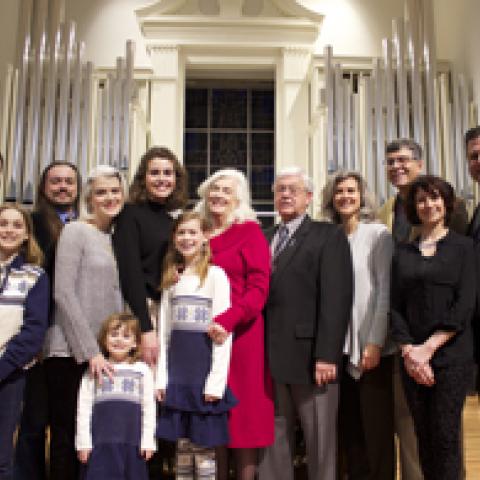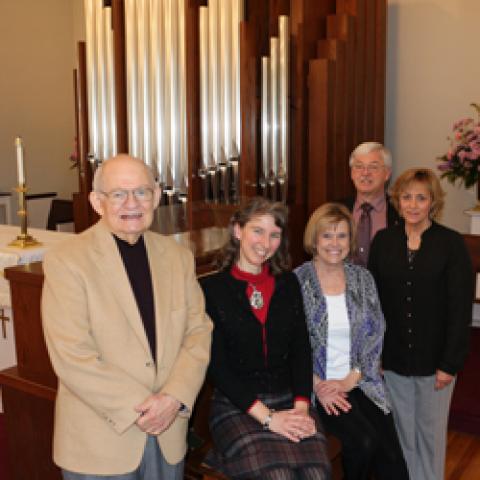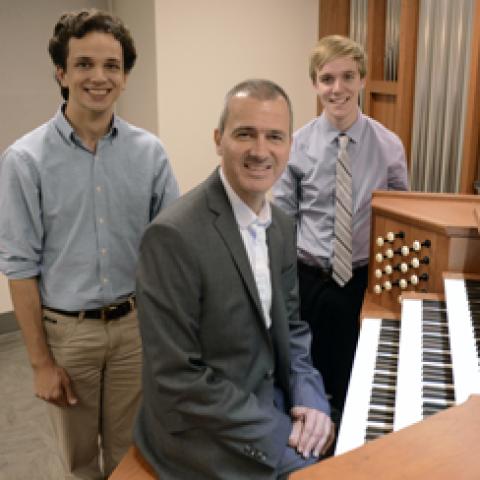The Organ Historical Society’s 59th Annual Convention took place in central New York with the historic Genesee Grande Hotel, Syracuse, as convention headquarters, though some of us stayed at the equally pleasant Park View Hotel three or four blocks away, owing to a lack of accommodation at the main hotel. One might not normally bother with such details, but I would like to begin by mentioning that Birnie’s Bus Service of Rome, New York, provided the OHS with the best bus service I think I have ever experienced on any convention. I also have to say that after the Vermont convention of last year, perhaps the best OHS convention ever, I was not expecting the Syracuse convention to be nearly as good. But in the event, I was very presently surprised to find that, if a little shorter than last year’s, it was in many ways equally fine. Enormous credit for this is due to Ryan J. Boyle, the chair of the convention, and his committee, as well as the Richmond staff and the Board of Directors of the OHS.
Sunday, August 10, and Monday, August 11
On Sunday, August 10, there was a pre-convention tour of New York State wineries, and on Monday morning there were further wine events, tours, and museum visits. The pre-convention events included a recital by Jillian Gardner, a student of James David Christie at the Oberlin College Conservatory of Music. Gardner’s recital took place in the Lodi Historical Society on E. & G. G. Hook Opus 140, a two-manual organ built in 1852.
The convention proper, however, began at 8 p.m. on Monday evening with Hector Olivera’s recital on the 1952 Walter Holtkamp, Sr., III/61 organ, Job number 1659, in Hendricks Chapel, Syracuse University. This organ incorporates much of the action and pipework from the previous Aeolian organ, Opus 1771 of 1930. The instrument was designed in consultation with the redoubtable Arthur Poister (1898–1980), who served as music director of Hendricks Chapel from 1948 to 1965. Mr. Olivera is, of course, a great showman in the tradition of Virgil Fox and, ably assisted at the console by his frog Harry, gave us a very entertaining recital. His performance of the Aria from Bach’s Suite in D Major, BWV 1068, reminded me a great deal of Virgil’s. Among other things, he gave us some very interesting stereophonic cuckoo effects in the Allegro from Handel’s Organ Concerto No. 13 (“The Cuckoo and the Nightingale”), and ended with an improvisation on a submitted theme, which turned out to be the hymn tune Lasst uns erfreuen, finishing with a skillfully improvised fugue.
Tuesday, August 12
Tuesday, August 12, began with a short bus trip to Temple Concord in Syracuse. This is one of the oldest Reform synagogues in the United States; its present building dates from 1911.
Joby Bell treated us to a recital on the IV/44 Tellers organ, Opus 998 of 1965. The Tellers Organ Company, successors to A. B. Felgemaker & Co. of Erie, Pennsylvania, was of course a relatively local company in this part of the country. I had never heard any of their instruments from the 1960s before and was quite impressed with the sound of this organ. It has a neo-baroque specification, but is a warm sound with no tendency toward screechiness in the voicing, such as one finds in many instruments of the period. That such an instrument could sound so fine in a relatively unfavorable acoustic is a great tribute to the Tellers firm. The organ proved an excellent medium for Bach’s Prelude and Fugue in E-flat (“St. Anne”) while Jean-Yves Daniel-Lesur’s haunting In Paradisum gave Joby Bell the opportunity to show off the contrasting flutes of the Antiphonal and Echo divisions. The recital ended with a fine performance Sowerby’s Pageant.
We proceeded then to St. Anthony of Padua Catholic Church in Syracuse where Silviya Mateva, one of last year’s OHS Biggs Fellows, treated us to a recital on the church’s 1951 Casavant organ. This organ, which replaced an earlier one by Morey of Utica, was an old-style Stephen Stoot Casavant, built at the time when the firm had hardly begun to take note of the neo-classical movement. Its rich tone suited it extremely well to the Elegy of William Grant Still, and Ms. Mateva made good use of the Swell Cornet as a solo stop in Bach’s Chorale Prelude on ‘Allein Gott in der Höh sei ehr,’ BWV 662. Lionel Rogg’s Partita on ‘Nun freut euch’ also came off very well despite being a modern piece in neo-baroque style. I did feel, however, that the organ was a little heavy for the Buxtehude Präludium und Fuge D-Dur, BuxWV 139, and though it was very well played, I rather wished she could have chosen a piece more suited to this particular instrument.
After lunch at the Franciscan Church of the Assumption, where we were able to inspect the historic plumbing in the restrooms, we took the buses to St. Cecilia’s Catholic Church in Solvay, New York. The City of Solvay developed largely around Ernest Solvay’s ammonia-soda process for the production of sodium carbonate. The Solvay plant closed in 1986, leaving the city both economically depressed and environmentally compromised, but following massive redevelopment, things have greatly improved in recent years. I was particularly looking forward to hearing the organ at St. Cecilia’s, a II/15 tracker by J. H. Willcox & Co. of Boston, Opus 23 of 1872. Since in the 1980s, I belonged to Trinity Episcopal Church in Bethlehem, Pennsylvania, which originally possessed an 1872 Willcox with a practically identical stoplist; this organ had been electrified by Durner c. 1920 and replaced by Aeolian-Skinner Opus 1240 in 1955.
I was therefore looking forward to hearing what an original Willcox sounded like, as there are very few of them still around. Organist and organ-builder J. H. Willcox was one of several members of the E. & G. G. Hook firm that left and started their own companies shortly after Frank Hastings took over from the Hook brothers. After a couple of years, J. H. Willcox & Co. morphed into Hutchings, Plaisted & Co., and then into Hutchings & Co. I was by no means disappointed in my expectations, since the Willcox organ turned out to be one of the outstanding organs of the convention, and Christopher Marks gave an excellent recital on it. The organ has some exquisite strings and flutes, a bright, sparkling Great chorus and a surprisingly impressive full Swell. Among other things, the recital included some interesting pieces by American composers. Among these were the Miniature Suite of James H. Rogers (1857–1940) and the Variations on an American Air (Stephen Foster’s “Old Folks at Home”) by I. V. Flagler (1844–1909), of whom there will be more to say more anon. The recital concluded with the first ever performance of Romance and Tarantella by Kurt Knecht (b. 1971), commissioned for this convention by Christopher Marks.
Later in the afternoon, we went to Westminster Presbyterian Church in Syracuse to visit another delightful tracker organ, a II/21 instrument William A. Johnson of Westfield, Massachusetts, Opus 43 of 1855, enlarged by Johnson & Son c. 1865. The recital was given by Robert Kerner, one of the principals of the organbuilding firm of Kerner & Merchant, and again we were by no means disappointed. Though more refined and less brilliant than the Willcox, the Johnson organ proved to be an excellent medium for both classical and romantic music, including Sweelinck, Buxtehude, Bach, Franck, and Boëllmann. Kerner included some movements from Franck’s L’ Organiste, and I thought the beautiful flute stops of the Johnson organ were particularly effective in these. We heard again the Prière à Notre-Dame from Boëllmann’s Suite Gothique, also included in Hector Olivera’s recital at Hendricks Chapel the previous evening, and I have to say I much preferred hearing Mr. Kerner play it on the Johnson.
Later in the afternoon we took the buses to Plymouth Congregational Church in Syracuse, which is the home of one of the finest four-manual Möller organs I have ever heard, Opus 5827 of 1930, with some tasteful additions made by Kerner & Merchant in 2012. The organist was Bryan Anderson, a four-year student at the Curtis Institute who is surely going to be one of the outstanding organists of his day. Brilliant, yet quiet and unassuming, he played the recital entirely without music. The main work in his program was Karg-Elert’s Homage to Handel, a series of 54 variations on a ground bass. Besides being highly virtuosic, this is a wonderful piece to demonstrate an organ, since in the course of its 54 variations it uses just about every registration conceivable.
Following cocktails and dinner at the Drumlins Country Club, we finished Tuesday’s program with a recital given by the Syracuse University Organist (now on the University of Michigan faculty), Kola Owolabi, with Gabriel DiMartino, trumpet. This was performed on another three-manual Walter Holtkamp, Sr., organ, Job number 1649 of 1950, in the Setnor Auditorium, Crouse College, Syracuse University. It incorporates pipework from previous instruments by Roosevelt and Aeolian. It was a ground-breaking instrument at the time it was completed. Crouse College was originally the women’s department of Syracuse University; then it became the performing arts center, and now—the artists and dramatists having moved to other buildings—it is occupied exclusively by the music department. The concert included Bach’s Prelude and Fugue in G Major, BWV 541, as well as Mussorgsky’s Pictures at an Exhibition transcribed for organ and trumpet by Vincent DiMartino, Gabriel DiMartino, and Kola Owolabi. In the middle of the recital, we also heard Owolabi play J. G. Walther’s Partita on ‘Meinen Jesum lass ich nicht’ on the other organ in Setnor Auditorium, a I/4 tracker with pull-down pedal by the Strasbourg firm of Schwenkedel, Opus 123 of 1968. It is a very pretty little instrument of its kind. And so to bed . . .
Wednesday, August 13
The Wednesday program required us to get up a little earlier than normal for a day trip to Ithaca, New York. On the way we stopped at St. Mary’s Catholic Church in Cortland, New York, where John Ronald Daniels gave us a recital on the church’s II/21 Morey & Barnes tracker, Opus 165, which was first used on Christmas Day of 1895. The organ is feisty, bright, and forthright. In some of its moods it reminded me of the work of Father Willis in England. It had previously been visited 34 years ago on the 1980 OHS convention.
Following some several solo organ pieces by Théodore Salomé, Daniels was joined by the Clinton String Quartet in Salomé’s exceptionally beautiful Berceuse, op. 59, no. 5 (1894). This piece was written for a concert organized by Guilmant, but not performed, and has rarely if ever been performed since until now. Following it came Rheinberger’s well-known Cantilène from Sonata 11, which furnished an opportunity to show off the organ’s uncommonly fine Oboe. The Trumpet was similarly showcased in David N. Johnson’s Trumpet Tune in E. The recital ended with Lefébure-Wély’s wonderfully tasteless Boléro de concert. I shall probably not be around to see it, but it is very much my hope that this fine Morey & Barnes organ will still be there to be enjoyed by future OHS members in another 34 years’ time.
On our arrival in Utica we split into two groups, and the group I was in went first to Trinity Lutheran Church for a short recital by Annie Laver on John Brombaugh’s Opus 2 of 1966, a small one-manual-and-pedal instrument of nine ranks. The recital included works by Buxtehude, Böhm, and Reincken. Following lunch at First Presbyterian Church (whose fine IV/84 instrument by Russell & Co., Opus 47 of 2006, we were unfortunately unable to hear owing to construction work in the church) we went to the First Unitarian Society of Ithaca, New York, which is the home of Hellmuth Wolff & Associés Opus 16 of 1975. This is a II/26 tracker, and it has a sister organ in Wolff’s Opus 6, formerly in the Anabel Taylor Chapel of Cornell University in Ithaca, and now at Binghamton University (SUNY). Jonathan Biggers, who played the recital at the Unitarian Church in Ithaca, is professor of organ at Binghamton, so he gets to play the other Wolff organ there. He gave an excellent recital of Bach, Böhm, and Bruhns (the G major), and the organ sounded exceedingly fine, though perhaps a little loud for the room.
After lunch we moved to the Uris Hall Auditorium for the OHS Annual Meeting, after which we divided into three groups, which perambulated the Cornell campus for the rest of the afternoon. My group went first to the Sage Chapel of Cornell University for a recital given by Gregory Crowell on the I/7 Vicedomini organ built in Italy in 1748. As well as seven speaking stops, this instrument has an Ussignoli (Nightingale) stop and a double-acting Sforzando marked “Tiratutti.” Appropriately, Mr. Crowell’s recital consisted mostly of early Italian music, though an exception was James Woodman’s Gagliardo, which gave us an opportunity to hear the Ussignoli. Another piece, Bernardo Storace’s Ciaccona, enabled us to hear the 8-ft. Voce Umana (Principal Celeste).
Our group next went to Barnes Hall Auditorium for a lecture by Cornell music professor and university organist, Annette Richards, on “The Genesis of the Cornell Baroque Organ,” describing how the Wolff organ in the Anabel Taylor Chapel was replaced by a replica Schnitger organ built in collaboration with GOArt at the University of Gothenburg, Sweden. This collaborative effort was overseen by Munetaka Yokota, and involved a cooperative enterprise between workers from GOArt, Parsons Pipe Organs, and CCSN Woodworking of Ithaca, the latter being responsible for the case. The Schnitger organ chosen for replication was that of the Court Chapel at Charlottenburg, built in 1706 and unfortunately destroyed in World War II, though not before every aspect of it had been painstakingly catalogued by Karl Schucker. The case was based on the instrument at Claustahl-Zellerfeld and the mechanism on several North German Schnitger organs. However, the tonal design of the Charlottenburg organ that has been duplicated was most unusual in being, unlike other Schnitger organs, designed primarily for the performance of music of the Galant style. The room where the lecture was held also contains a GOArt pipe organ, a I/5 with divided keyboard built in 2003, but we unfortunately did not get to hear this.
After the lecture we went to the Anabel Taylor Chapel to hear a recital on the II/42 GOArt Schnitger replica organ of 2009–10 that Professor Richards had been discussing. The recital was given by another Cornell music professor, David Yearsley, who appropriately included mostly repertoire from the Galant style. The organ case dominates the Anabel Taylor Chapel, and I was afraid that the sound might prove overwhelming. I was pleasantly surprised, however, to discover that the volume was just right for the room, and that it was indeed a magnificent instrument of its kind.
Following a cash bar and dinner at the Celebrations Banquet Hall in Ithaca, we returned to Sage Chapel for the evening recital given by Christopher Houlihan on the celebrated III/68 Aeolian-Skinner organ, Opus 1009 of 1940, which incorporates quite a bit of pipework from the previous organ, Ernest M. Skinner Company Opus 175 of 1909. This was a landmark organ in its day. The recital included three works by J. S. Bach, together with the Grande pièce symphonique of Franck. Although the latter is probably my least favorite of Franck’s twelve major organ works—I find it a little long and rambling—Houlihan gave a magnificent performance of it. At the end of the recital we were treated to the Scherzo from Vierne’s Symphony No. 2 as an encore, and I also thought this came off very well on the organ. Houlihan played the three Bach pieces, including the Passacaglia in C Minor BWV 582, extremely well, but here I thought the Aeolian-Skinner basses a little ponderous for Bach—certainly in comparison with the GOArt organ we had just heard. Organ design has come a long way since 1940! And so back to Syracuse . . .
Thursday, August 14
The doyen of Syracuse organists is Cornell University Organist Emeritus Will Headlee, a familiar figure at OHS conventions. Thursday, August 14, began with a recital given by Professor Headlee on the Ernest White Möller organ at the Episcopal Church of the Saviour, Syracuse, New York. This was M. P. Möller Opus 9734, an instrument of three manuals and five divisions, built in 1962. The recital was titled, “Homage to Ernest White 1901–1980,” and I was expecting something rather screechy-sounding. Once again I was pleasantly surprised for, as Professor Headlee explained, the church asked for an organ in the English Cathedral tradition and this is exactly what Ernest White gave them. Two manual doubles and independent, pure-tuned mutations on the Pedal division add to the instrument’s rich effect. Indeed, I thought it in many ways more useful as an eclectic organ than the Aeolian-Skinner in Sage Chapel, being equally at home, for example, in works by Bach and Karg-Elert.
Following this we all piled in the buses for a visit to St. Michael’s Lutheran Church in Camillus, New York, home of a II/21 Schlicker of 1965. Allison Evans Henry gave a recital of Bach, Howells, Vierne, and from the Syracuse Collection, Homage to Persichetti by Janet M. Correll (b. 1942). We also heard a charming arrangement for Vivaldi’s Concerto in D Major, arranged for organ and classical guitar. The solo guitarist was Timothy Schmidt. This was a very nice little organ, and indeed I don’t think a small church looking for value for money in 1965 could have done any better than to buy a Schlicker organ such as this. We then split into groups again, and my group went first to Cazenovia College for an extremely pleasant luncheon. For anyone who is looking for a college for their undergraduate degree and who is especially fond of ice cream, of which they had a splendid selection, Cazenovia College ought to be near the top of the list.
In the afternoon we went first to the First Presbyterian Church in Cazenovia, home of C. B. Fisk Opus 70, a II/32 tracker of 1976. The organ contains some pipework from the previous instrument by J. G. Marklove. Christopher J. Howerter treated us to a program of de Grigny, Bach, Buxtehude, and Canadian composer Sir Ernest Campbell MacMillan’s Cortège académique. We also heard our Convention Chair, Ryan J. Boyle, singing bass, and alto Abby Witmer, accompanied by the organ in Dudley Buck’s “The Lord is My Light.” This is an excellent organ all round; one of Charles Fisk’s best, I would say.
We went then to the May Memorial Unitarian-Universalist Society of Syracuse where we heard a recital given by Glenn Kime on the II/28 Holtkamp organ, Job Number 1797 of 1965. The repertoire consisted of Pachelbel’s Praeludium in D Minor, three Bach chorale preludes, the last movement of Mendelssohn’s Sonata No. 1, and two movements from Spirits and Places by Ernst Bacon. These were very pleasant and most unusual, and we were honored to have the composer’s widow in the audience. In spite of it having no swellbox, I thought that this was the most versatile and attractive of all the Holtkamp instruments we heard during the convention.
Following dinner in the Armory Square neighborhood of Syracuse, we walked to the Catholic Cathedral of the Immaculate Conception for the last, and one might say culminating, recital of the OHS convention. Immaculate Conception’s organ is a three-manual built by Frank Roosevelt of New York City, Opus 520 of 1892, rebuilt and tastefully augmented by Schantz in 1980. Schantz’s head voicer, Bob Maye, did excellent work matching the new work to the old, and the organ now has three manuals and pedals and 60 ranks. Our recitalist was the internationally acclaimed Diane Meredith Belcher, who played an excellent program commencing with the Passacaglia on a theme by Dunstable by John Weaver, who was present in the audience and indeed as an OHS member had attended the whole of the convention. This was followed by the Lullaby from the Second Suite of Calvin Hampton, Gigout’s Pièce jubilaire en forme de prélude et fugue, Étoile du soir from the third suite of Vierne’s Pièces de fantaisie, and Rheinberger’s magnificent Sonata No. 8 in E Minor. Altogether a wonderful end to a wonderful OHS convention.
Friday, August 15
On Friday morning, my wife and I departed Syracuse and wended our weary way through Ontario and back to the Midwest. The lucky few got to stay another day for the optional post-convention tour. This included visits to Johnson & Son Opus 510 of 1878 at First Baptist Church, Meridian, New York, to Skinner Organ Company Opus 644 of 1927 at St. James Episcopal Church, Skaneateles, New York, a Steere & Turner of c. 1891 at Willard Memorial Chapel, Auburn, New York, and St. Mary of the Assumption Roman Catholic Church in Auburn, New York, which has both an 1890 Carl Barckhoff Church Organ Co. organ and another one of 1872 by Garret House. Recitals were given by Carol Britt, Rosalind Mohnsen, Matthias Schmelmer, and Nicholas Bideler. For an even more select few who had been able to register early, there was also a lunch cruise aboard the Judge Ben Wiles
motor launch.
